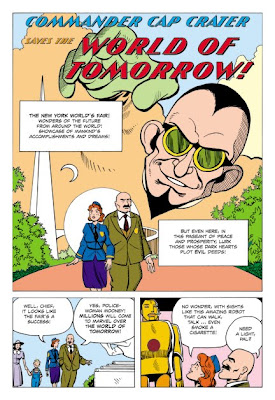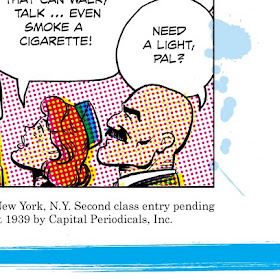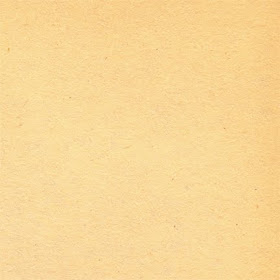It occurred to me I hadn't done a "How To" post in a while. Or more accurately, a "How I Do It" post, since I always disclaim that my way isn't necessarily the best or right way. It's just mine.
Today's is about putting together one page of
Whatever Happened to the World of Tomorrow--specifically, page 27, which is one of the early comic-within-a-comic pages meant to simulate an actual comic book from 1939. If you haven't seen
WHTTWOT, the conceit was that these were the very same comics my characters were reading. The interior pages of these fake comics were printed on a rough newsprint paper stock, very different from the smooth glossy pages in the rest of the book. The amount of effort that went into mimicking a 70-year-old 10-cent comic recalls Mae West's line, "It cost a lot to make me look this cheap."
I started with the line art, which is India ink on two-ply Bristol board, 10 x 15 inches (~25 x 38 cm). You may be able to see some of my blue pencil underdrawing in the image below.
 Black-and-white line art: actual ink on paper!
Black-and-white line art: actual ink on paper!
Mindful of the tools and techniques that would've been used at the time, I drew with crowquill and other pen nibs rather than my usual brush, and used more hatching than I normally would. Backgrounds are deliberately less detailed and a bit abstract, befitting the era. On this page, I drew caption boxes and word balloons to be filled later with digital type. I later decided that was a mistake (much harder to edit) and began doing the boxes and balloons digitally as well.
I scanned the line art into Photoshop at 1200 dpi (huge file!), converted to Bitmap to get very clean black-and-white lines with no grays or fuzzy edges, then converted to CMYK to color it. Coloring was more complicated than filling in areas with the Photoshop bucket, worthy of a series of posts on its own. First, I used the very limited color palette available to comic printers in 1939 (my palette grew for the later comics because printing practices improved).
 I only cheated on one detail: Officer Mooney's orange-red hair is a color that wouldn't have been available then. It was worth it; I've got a thing for redheads.
I only cheated on one detail: Officer Mooney's orange-red hair is a color that wouldn't have been available then. It was worth it; I've got a thing for redheads.
Second, I couldn't just color up to the edge of the black lines, or the next step in the process wouldn't work. Instead, I colored on a separate "layer" in Photoshop (think of it as coloring on a transparency laid atop the line art) and made sure to overlap the black lines so that the colors solidly butted up against each other with no gaps.
All colors in a comic book are combinations of transparent cyan, magenta, and yellow, with which you can make red, green, purple, brown, etc. Printing a comic is a four-color process: you run paper through the machine four times to imprint the cyan, magenta, yellow and black inks. "Screening" is the process of breaking colors up into very fine dots so when printed they give the illusion of different hues and shades:
 Roy Lichtenstein, eat your heart out.
Roy Lichtenstein, eat your heart out.
I believe there's actually a button in Photoshop that'll screen for you in one quick step, but I didn't use it. I wanted to carefully control and manipulate the size and angles of the different colored dots (notice above that the red dots and blue dots line up at different angles). This was another variable that I changed to represent comics from different eras: as the years progress, the dots get finer and the "print quality" gets better.
"Registration" means how well the paper's four passes through the printer line up. Because this was supposed to be a cheap, poorly printed comic book, I wanted my registration to be poor. This was another quality that gradually improved in my fake comics as decades passed. Because I'd separated my cyan, magenta and yellow colors into three individual layers, I was able to nudge them around to deliberately throw them off-register. In the close-up below, notice how the blue is bumped to the left so it doesn't fill the letters, while the red and yellow are scootched slightly to the right (the yellow's hard to see, but you can spot a little yellow halo to the right of the red letters).

Somewhere around this step I added the indicia, or the (fake) legal notice, to the bottom of the page. In each era, I used appropriate language and typefaces taken from actual comic books, substituting my fictional "Capital Periodicals" for the real ones. This one was modeled after the indicia in Action #1, the first Superman comic, published in June 1938. The address 115 West 18th St., New York City is where my publisher Abrams is located. Hey, there could have been a comic book publisher working there years ago.
.
 (Funny digression: although I had examples of indicia from 1965 and 1975 in my personal comic book collection, I didn't have any from 1955. So when I went to the San Diego Comic-Con that year (2007?), I wandered from dealer to dealer asking to see the cheapest comic from 1955 they had. Didn't care about the title, story, character, writer, artist, publisher or condition; I just wanted it for its indicia. Some eyed me as if I were crazy. "Weirdest comic book collection ever." I think I finally found a beaten-up old Batman for $5.)
(Funny digression: although I had examples of indicia from 1965 and 1975 in my personal comic book collection, I didn't have any from 1955. So when I went to the San Diego Comic-Con that year (2007?), I wandered from dealer to dealer asking to see the cheapest comic from 1955 they had. Didn't care about the title, story, character, writer, artist, publisher or condition; I just wanted it for its indicia. Some eyed me as if I were crazy. "Weirdest comic book collection ever." I think I finally found a beaten-up old Batman for $5.)
To reinforce the idea that these comics were cheap, disposable ephemera, I wanted to introduce even more printing errors--which, again, became less frequent as the fake years passed. So I added blotches and smears to suggest poorly cleaned and maintained printing equipment that defaced the paper as it rolled through. The light blue spatters below were made by dripping black ink drops onto a sheet of white paper, scanning them, and turning them cyan and transparent. Similar process for the smudge. I created quite a library of various drips, blobs and smears.
.

One of my favorite stories about publishing
WHTTWOT involves the paper. As I mentioned, Editor Charlie and I had the idea to print these comics-within-the-comic on cheap pulp paper. Now, my publisher, Abrams, has a long history as a very high-quality publisher of high-end art books, and the Abrams paper people kept bringing Editor Charlie samples of paper that were way too good. Too white, too thick, too glossy. They just weren't getting it. Finally, Editor Charlie brought them an old comic book from home. The paper people looked at it; felt it. The light bulb went on. "Oh!" they exclaimed. "You want
really bad paper!" Yes, we want really bad paper. We got it.
.As bad as the paper actually is, I wanted to make it look worse. So over each page, printed right up to the edge of the paper, I added an artificial transparent newsprint texture to yellow and age them even more. To get the texture, I dug an old sheet of newsprint from my college art portfolio and scanned the back of the drawing to capture an authentic blotchy, pulpy yellow:
.
It's hard to see in this scan, but the right edge of this piece is quite a bit browner than the rest because it had been exposed to more light over the years. When I laid this texture over each page, I made sure that the darker edge always lined up toward the outside, where the comic book pages would've gotten more light. This newsprint texture was another variable I could "improve" as I mimicked comics from subsequent decades. The four fake comics throughout the book are printed on the same pulp paper, but it gets less and less yellow as the years go by until in the "1975" comic the artificial texture is barely there at all.
.Finally, a tiny detail I'm proud of. Comics are held together with two staples through their spines. Those staples are lubricated with trace amounts of oil, and over the decades that oil would sometimes leach into the surrounding paper. So on each page, where the staples would go, I darkened the newsprint texture to represent oil stains from the staples:

The result:

Then I did the same thing for another 39 pages of fake comics plus their covers, which were printed on the regular paper used through the rest of the book, but bled (that is, printed to the very edge of the page) and yellowed to look like comic books as well.
.
These pages were interesting to proof. First, we made sure to alert the printer that they were supposed to look bad on purpose so they wouldn't try to fix them. Then, when the first samples rolled off the press for Abrams editors and I to inspect and approve, I didn't quite know how to approach the job. I wanted them to look as bad as possible; what, exactly, would have constituted a flaw? Any errors introduced by the actual printing process would just be icing on the cake as far as I was concerned. In fact, I don't believe I made any corrections to any of these pages.
.
This was obviously a pretty laborious process, but was it also fun? Yes. Was it worth the effort? I don't know. It was to me. Even if no one else notices, I'll always know I got it as right as I could. It was a labor of love.
.
 When I finished my Mom's Cancer webcomic, printed it all out, and shoved it into an envelope addressed to "Dear Editor," it landed on Charlie Kochman's desk. Now the executive editor of Abrams ComicArts, Charlie had been hired by publisher Harry N. Abrams specifically to develop a graphic novel/pop culture line, and Mom's Cancer was the first project he signed. A couple of years later, Charlie was again my editor on Whatever Happened to the World of Tomorrow. In gratitude, I fed him to a giant prairie dog.
When I finished my Mom's Cancer webcomic, printed it all out, and shoved it into an envelope addressed to "Dear Editor," it landed on Charlie Kochman's desk. Now the executive editor of Abrams ComicArts, Charlie had been hired by publisher Harry N. Abrams specifically to develop a graphic novel/pop culture line, and Mom's Cancer was the first project he signed. A couple of years later, Charlie was again my editor on Whatever Happened to the World of Tomorrow. In gratitude, I fed him to a giant prairie dog.


















 I only cheated on one detail: Officer Mooney's orange-red hair is a color that wouldn't have been available then. It was worth it; I've got a thing for redheads.
I only cheated on one detail: Officer Mooney's orange-red hair is a color that wouldn't have been available then. It was worth it; I've got a thing for redheads. 

 (Funny digression: although I had examples of indicia from 1965 and 1975 in my personal comic book collection, I didn't have any from 1955. So when I went to the San Diego Comic-Con that year (2007?), I wandered from dealer to dealer asking to see the cheapest comic from 1955 they had. Didn't care about the title, story, character, writer, artist, publisher or condition; I just wanted it for its indicia. Some eyed me as if I were crazy. "Weirdest comic book collection ever." I think I finally found a beaten-up old Batman for $5.)
(Funny digression: although I had examples of indicia from 1965 and 1975 in my personal comic book collection, I didn't have any from 1955. So when I went to the San Diego Comic-Con that year (2007?), I wandered from dealer to dealer asking to see the cheapest comic from 1955 they had. Didn't care about the title, story, character, writer, artist, publisher or condition; I just wanted it for its indicia. Some eyed me as if I were crazy. "Weirdest comic book collection ever." I think I finally found a beaten-up old Batman for $5.) 


